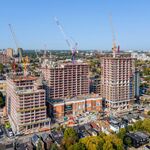Note that that density map shows *average* population densities. Entire clusters of commie blocks disappear and some industrial and park lands become quite dense due to this averaging out. It does a decent job of showing which sectors of the city have the most people, but it does little to assist transit planning for local corridors.
CDL's first map in that thread (
http://urbantoronto.ca/showthread.php?t=7238) is better since it shows actual population densities. Give him credit if you use it though

Jobs and retail and schools and stuff are missing from such a map and these are the places people are actually travelling to, so population is only half the discussion. People keep bringing up Sheppard East vs Finch East but anyone even remotely familiar with the two knows that Sheppard warrants more or a higher order of transit than Finch...always has, always will, even though current population densities may not make this so clear-cut.
Missing from these density debates - as well as from the entire Transfer City process - is a frank discussion of what is physically appropriate for each street. LRT lines were drawn on the map along corridors like Jane and it didn't take long for people to figure out that some hideously expensive tunnels might be needed. If they had bothered to spend more than 5 seconds planning Transfer City, a practical and realistic line could have been proposed for a corridor like Wilson. Or Dufferin instead of Jane even with the tunnel, or Lawrence instead of Morningside. Finch East may seem like a perfect place for LRT but traffic is not an issue, so why waste all that money on a streetcar ROW? The same applies to many corridors - if buses work, keep them and improve them, and if buses won't work, replace them. Transfer City as a plan is a complete disaster and everyone knows it. Other people have mentioned this and they're right: one consequence will be it'll really poison the atmosphere in Toronto in terms of future LRT lines getting built where they'd work well, like Kipling or Steeles or McCowan or a dozen other places. I'm not a big fan of BRT since any corridor that needs infrastructure above and beyond Rocket/Express buses and an occasional diamond lane or queue-jump might as well get an LRT line. Then, of course, we need to throw improve GO lines into the mix.
It's all quite simple. Ridership is extremely malleable and entire neighbourhoods' transit usage can be manipulated by such simple things as parking conditions/costs or traffic light [de]synchronization. The city - *not* its transit lines - decides what gets built and where, though good/bad transit can speed/slow the progress of development. Toronto has such an enormous quantity of suburban bus routes dumping riders onto other routes and subway lines that an enormous percentage of this ridership can be shifted around. Everyone that bitches about capacity should be executed...transit vehicles are effectively full at barely half capacity and by about 2/3 they are extremely uncomfortable and delays mount. Capacity is a theoretical, not a goal.
The more a corridor needs or warrants grade-separation, the more obvious a subway becomes, and when we're extending subway lines, subway extensions are obviously the only option. Only the most fanatical ideologue would think that Toronto does not need to expand its subway system or that Kennedy is the best place to terminate the Danforth line. This forum has some fanatical ideologues but they should know that they only have a few dozen real-world compatriots in Toronto and that the vast, vast majority of the actual living, breathing, and transit-riding public prefers subways over streetcar ROWs. That's just the way it is.




